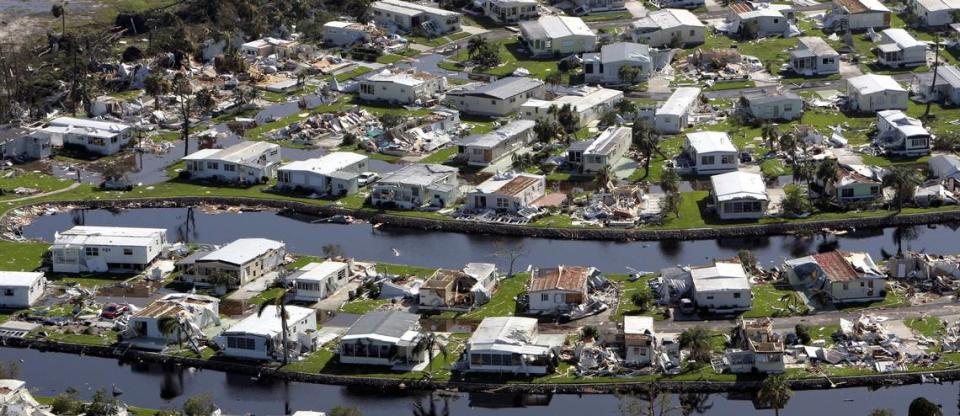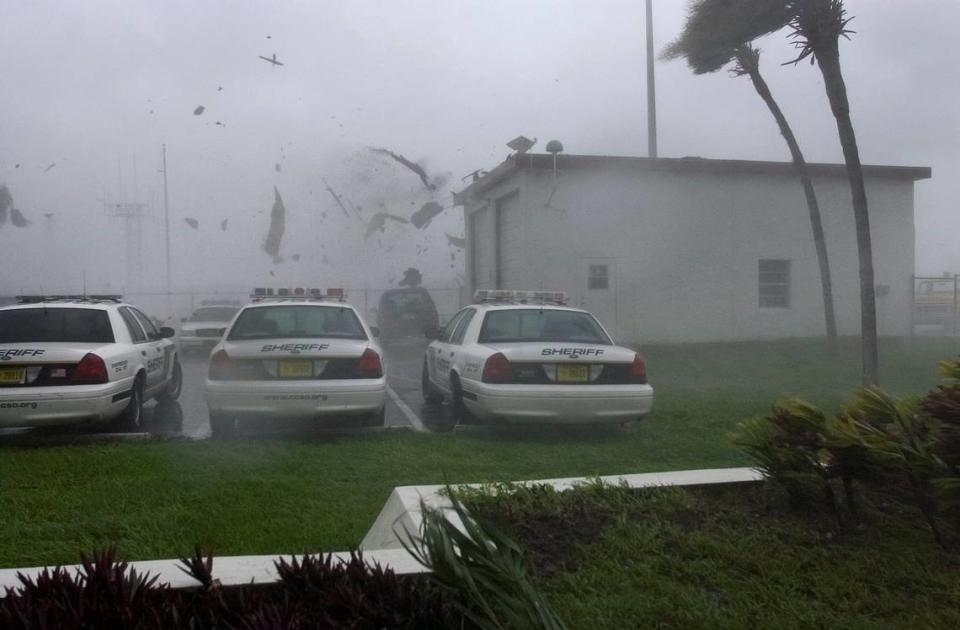How bad would a Category 4 hurricane be in Florida? Here’s a look at past storms
Tropical Storm Ian is on its way to Florida, and forecasters say it could become a major Category 4 hurricane over the Gulf of Mexico. What kind of damage could that cause?
Because hurricanes are ranked on a scale of Category 1 to Category 5, a Category 4 storm is only one step down from the strongest storm possible.
According to a guide put together by the National Hurricane Center, Ian could cause “catastrophic damage” at that level.
These are some of the risks associated with a Category 4 storm:
Extreme wind speeds
Hurricanes earn their ratings based on wind speeds. Category 4 hurricanes have sustained winds between 130 and 156 mph.
In an explainer video from the Weather Channel, meteorologist Danielle Banks said those wind speeds are enough to uproot trees and knock down power poles, causing extended power outages.
High wind speeds can also destroy or cause extensive damage to most homes. NHC experts say the wind from a Category 4 storm brings a “very high risk of injury or death” because of the flying or falling debris.
The wind will be strong enough to lift debris in the air, which could send it flying through windows, meteorologists say.
Strong winds will also be the primary cause of damage to homes in the area of a storm. The NHC says “nearly all” mobile homes built before 1994 and a “high percentage” of new mobile homes would be destroyed by a Category 4 storm.
A Category 4 storm can cause significant damage to frame-built homes, too. Even well-built homes could sustain damage to the roof, doors and windows.
Large storm size
Because hurricanes earn their categories based on wind speed alone, categories do not account for the overall size of a storm. While a storm’s category is not linked to the size of the storm, meteorologists say it’s important to account for just how large a storm can be.
While some parts of Florida do not appear inside the forecast graphics predicting Ian’s path, the entire state should expect to be affected by tropical-storm-force winds and heavy rains, experts say. Even the outer edges of a Category 4 hurricane can be deadly.
But every storm is different. Instead of basing their decisions on a hurricane’s category alone, residents should be sure to follow guidance from local officials and monitor the forecast in order to make an informed decision.
Power outages
Near the path of a Category 4 storm, you can be expected to lose power for days or weeks.
Trees or the wind will knock down power lines. Downed trees will also block the road, making it difficult for utility workers to access the area and restore power.
Storm surge flooding
The possibility of flash flooding is a possibility in any hurricane, but a Category 4 storm can bring a strong storm surge, especially in coastal communities.
Storm surge happens when a hurricane pushes water from the ocean up onto the shore, which can suddenly bring several feet of water above ground. The National Oceanic and Atmospheric Administration reports that the storm surge is the most deadly part of any hurricane.
About half of the deaths attributed to hurricanes are caused by storm surges, NOAA said in a hurricane guide.
What is an example of a Category 4 hurricane?
An example of a Category 4 hurricane is Hurricane Charley, which made landfall in Punta Gorda in 2004.
The storm had crossed Cuba as a Category 3 storm, but it strengthened quickly in the Gulf of Mexico before battering Southwest Florida as a Category 4 storm with wind speeds of up to 145 mph.
According to the National Hurricane Center, Charley is remembered as the second costliest hurricane in United States history, causing nearly $15 billion in damage. The storm was also responsible for 10 deaths throughout the nation.

Hurricane Katrina reached Category 5 strength over the Gulf and weakened to a Category 3 just before landfall near New Orleans and the Mississippi Coast. It was one of the most destructive hurricanes in the nation’s history.
Ian is forecast to reach Category 4 strength over water, but weather conditions could weaken it to a Category 3 at landfall.
Saffir-Simpson Scale
Category 1
Winds 74-95 mph (64-82 kt or 119-153 km/hr)
Very dangerous winds will produce some damage: Well-constructed frame homes could have damage to roof, shingles, vinyl siding and gutters. Large branches of trees will snap and shallowly rooted trees may be toppled. Extensive damage to power lines and poles likely will result in power outages that could last a few to several days.
Irene of 1999, Katrina of 2005, and several others were Category 1 hurricanes at landfall in South Florida.
Category 2
Winds 96-110 mph (83-95 kt or 154-177 km/hr).
Extremely dangerous winds will cause extensive damage: Well-constructed frame homes could sustain major roof and siding damage. Many shallowly rooted trees will be snapped or uprooted and block numerous roads. Near-total power loss is expected with outages that could last from several days to weeks.
Frances of 2004 was a Category Two when it hit just north of Palm Beach County, along with at least 10 other hurricanes which have struck South Florida since 1894.
Category 3
Winds 111-129 mph (96-112 kt or 178-208 km/hr)
Devastating damage will occur: Well-built framed homes may incur major damage or removal of roof decking and gable ends. Many trees will be snapped or uprooted, blocking numerous roads. Electricity and water will be unavailable for several days to weeks after the storm passes.
Unnamed hurricanes of 1909, 1910, 1929, 1933, 1945, and 1949 were all Category 3 storms when they struck South Florida, as were King of 1950, Betsy of 1965, Jeanne of 2004, and Irma of 2017.
Category 4
Winds 130-156 mph (113-136 kt or 209-251 km/hr)
Catastrophic damage will occur: Well-built framed homes can sustain severe damage with loss of most of the roof structure and/or some exterior walls. Most trees will be snapped or uprooted and power poles downed. Fallen trees and power poles will isolate residential areas. Power outages will last weeks to possibly months. Most of the area will be uninhabitable for weeks or months.
The 1888, 1900, 1919, 1926 Great Miami, 1928 Lake Okeechobee/Palm Beach, 1947, Donna of 1960 made landfall in South Florida as Category Four hurricanes.
Category 5
Winds 157 mph or higher (137 kt or higher or 252 km/hr or higher)
Catastrophic damage will occur: A high percentage of framed homes will be destroyed, with total roof failure and wall collapse. Fallen trees and power poles will isolate residential areas. Power outages will last for weeks to possibly months. Most of the area will be uninhabitable for weeks or months.
The Keys Hurricane of 1935 and Andrew of 1992 made landfall in South Florida as Category Five hurricanes.
— National Weather Service in Miami


